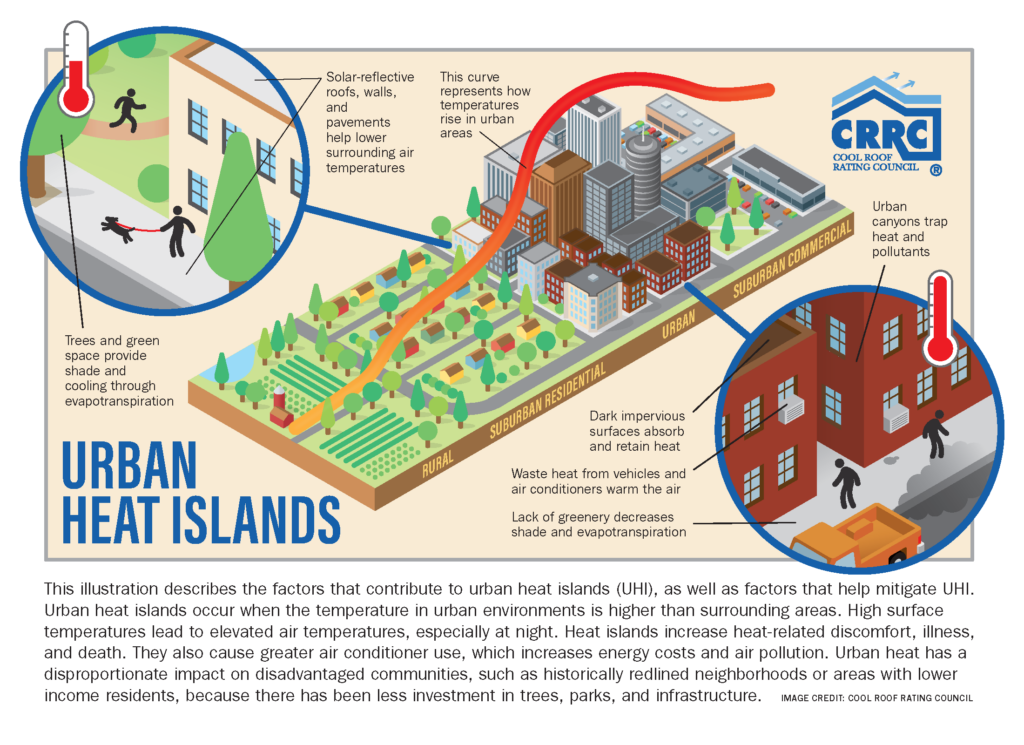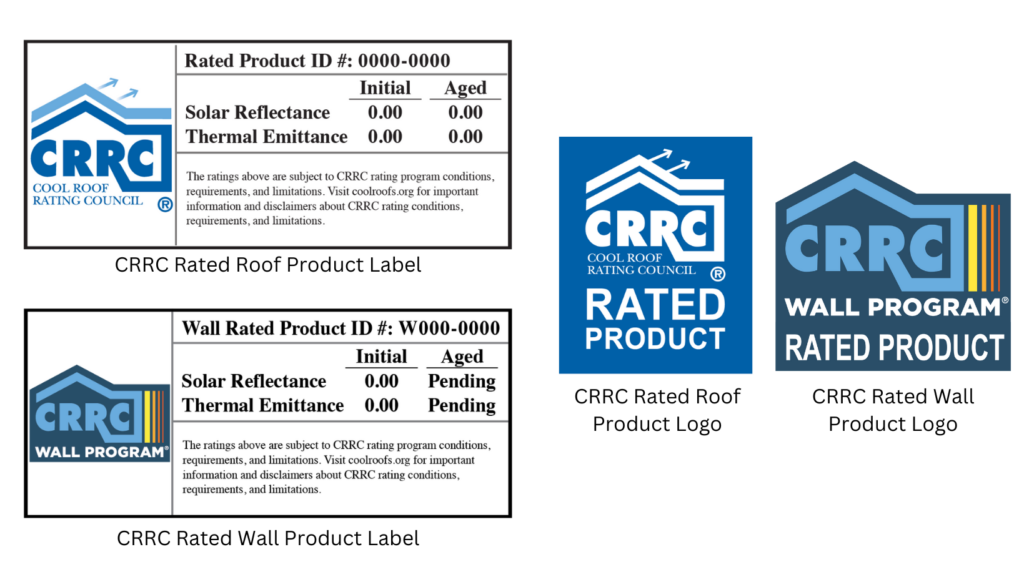This blog was authored by Audrey McGarrell, Cool Roof Rating Council (CRRC), Project Manager.
Cool roofs and walls are passive cooling strategies that help reduce building energy use, mitigate the impacts of urban heat islands and extreme heat, and help address some of the inequities faced by underserved communities in urban areas.
Getting to zero requires a variety of strategies and solutions, including those that boost a community’s resilience to climate impacts, particularly extreme heat. Materials that reflect sunlight, such as cool roofs and cool exterior walls, are cost-effective passive cooling measures that help reduce building energy use and peak demand and, importantly, mitigate the impacts of extreme heat and the urban heat island effect.
Extreme heat is one of the deadliest weather-related cause of human mortality in the United States, and heat can have serious impacts on human health and wellbeing. Low-income communities and communities of color are disproportionately affected by the impacts of extreme heat due in part to the urban heat island (UHI) effect. The UHI effect is a phenomenon in which urban areas are hotter than their suburban and rural surroundings. The intensity of the UHI effect can vary within an individual city, and low-income neighborhoods and communities of color are shown to be most affected. With heat waves growing more frequent, longer, and more intense due to climate change, the risk of health problems and death from extreme heat continues to rise. One solution to help keep homes, buildings, and communities cooler without increasing energy use is solar-reflective roofing and exterior wall materials. Referred to as “cool” surfaces, roofs and walls that highly reflect sunlight and efficiently emit heat that is absorbed reduce the amount of heat from the sun that makes its way into the building, known as solar heat gain, especially in older buildings and those with poor insulation. By reducing a building’s solar heat gain, cool roofs and walls decrease demand for air conditioner use. This helps lower energy bills for residents of buildings with air conditioning and, at a macro level, can reduce greenhouse gas emissions from electricity generation. During peak times, reduced cooling demand can also help lessen the use of as-needed power plants (i.e., peaker plants), which can be a major source of air pollution, and lower the risk of blackouts due to electrical grid strain.
One solution to help keep homes, buildings, and communities cooler without increasing energy use is solar-reflective roofing and exterior wall materials. Referred to as “cool” surfaces, roofs and walls that highly reflect sunlight and efficiently emit heat that is absorbed reduce the amount of heat from the sun that makes its way into the building, known as solar heat gain, especially in older buildings and those with poor insulation. By reducing a building’s solar heat gain, cool roofs and walls decrease demand for air conditioner use. This helps lower energy bills for residents of buildings with air conditioning and, at a macro level, can reduce greenhouse gas emissions from electricity generation. During peak times, reduced cooling demand can also help lessen the use of as-needed power plants (i.e., peaker plants), which can be a major source of air pollution, and lower the risk of blackouts due to electrical grid strain.
In un-air-conditioned buildings, the reduction in indoor air temperature improves occupant comfort and could be lifesaving during hot periods. Cool roofs and walls are also relatively inexpensive compared to other building measures, and financial incentives exist to help cities implement their use. Cool roofs and walls also help decrease the UHI effect outside of the building by reducing the outdoor air temperature. Due to their ability to passively cool buildings and the surrounding environment, various codes, policies, and programs promote the use of cool roofs and walls. Prescriptive and compliance credits for both cool roofs and walls are included in several model codes and standards, which become mandatory upon adoption by a state or local jurisdiction. These codes and standards include, but are not limited to, ASHRAE Standard 90.1, International Green Construction Code, International Energy Conservation Code, National Green Building Standard, and RESNET Standard 301. Voluntary green building programs such as LEED v4.1 and the Green Globes also offer credit for the use of cool roofs and walls.
Due to their ability to passively cool buildings and the surrounding environment, various codes, policies, and programs promote the use of cool roofs and walls. Prescriptive and compliance credits for both cool roofs and walls are included in several model codes and standards, which become mandatory upon adoption by a state or local jurisdiction. These codes and standards include, but are not limited to, ASHRAE Standard 90.1, International Green Construction Code, International Energy Conservation Code, National Green Building Standard, and RESNET Standard 301. Voluntary green building programs such as LEED v4.1 and the Green Globes also offer credit for the use of cool roofs and walls.
Several U.S. municipal and state building codes and zoning ordinances also require or promote the use of cool roofs. California has the most comprehensive cool roof requirements for nonresidential, single family, and multifamily buildings. Alabama, Florida, Georgia, Hawaii, and Texas also have cool roof prescriptions in their building codes. At the municipal level, Chicago, New York City, Los Angeles, Denver, Philadelphia, Washington, D.C., and Miami are just a handful of cities that have adopted cool roof requirements. Some jurisdictions such as Los Angeles, Louisville, and Austin also offer financial incentives for the installation of cool roofing materials. As for cool exterior walls, Hawaii offers an insulation trade-off and compliance credit for installing cool exterior walls, and California’s reach code, CALGreen, includes solar reflectance prescriptions for exterior walls. More information about codes, programs, and financial incentives can be found at coolroofs.org.
The “coolness” of a roofing or wall material is determined by two radiative properties: solar reflectance (SR) and thermal emittance (TE). Both properties are measured on a scale of zero to one, with one being the most reflective or emissive. Materials with a high solar reflectance are typically lighter in color or formulated with special components such as infrared-reflective pigments, additives, or granules.

In order to make informed decisions, it’s important to have access to credible SR and TE data. The Cool Roof Rating Council (CRRC) maintains free, publicly-available databases of radiative property ratings for roofing and exterior wall materials. These ratings are obtained using data from accredited independent testing laboratories that are reviewed and approved by the CRRC as an unbiased third-party. Products listed on the CRRC Rated Products Directories undergo three years of natural weathering and aged testing in order to provide an accurate indication of how they will perform over time once installed. CRRC ratings provide assurance that a product has been evaluated in accordance with strict protocols and industry-vetted test methods.
In addition to appearing on the CRRC Rated Products Directories, CRRC-rated products may also be marked with the CRRC Rated Product Logo, which indicates that the product is rated and that users should reference the applicable directory for more information, or labeled with a CRRC Rated Product Label, which contains the actual rated values.

Cool roofs and walls are an accessible strategy for improving energy efficiency, mitigating urban heat, and advancing heat equity. Third-party product ratings provide assurance of the radiative properties of product options and can help inform the development of cool roof and wall policies and programs, in addition to supporting compliance with existing requirements.
The CRRC is a 501(c)(3) non-profit organization formed in 1998 to develop accurate and credible methods for evaluating and labeling the radiative properties of roofing products and to disseminate the information to all interested parties. In 2019, the CRRC expanded to include the rating of exterior wall products. Please contact the CRRC at info@coolroofs.org or (866) 465-2523 for more information on its programs.
